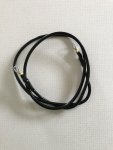bertsmobile1
Lawn Royalty
- Joined
- Nov 29, 2014
- Threads
- 65
- Messages
- 24,995
No the problem can not be the voltage regulator.
The fuel pump should have a black & a purple wire attached to it ( if I have the correct diagram )
The black wire goes to the PTO Clutch then to it's own ground
So working on the bad ground theory check for ground on the black wire at the pump.
The purple wire goes into the engine so will be on a switch of some sort, most likely a pressure switch on the fuel line or a control relay.
To take that any further I will need the full engine number to see If we can't find the Kohler engine wiring circuit.
You could remove the engine cover to see where the purple wire goes, but I fear it will be into an ECU which will be a replace only item.
The fuel pump should have a black & a purple wire attached to it ( if I have the correct diagram )
The black wire goes to the PTO Clutch then to it's own ground
So working on the bad ground theory check for ground on the black wire at the pump.
The purple wire goes into the engine so will be on a switch of some sort, most likely a pressure switch on the fuel line or a control relay.
To take that any further I will need the full engine number to see If we can't find the Kohler engine wiring circuit.
You could remove the engine cover to see where the purple wire goes, but I fear it will be into an ECU which will be a replace only item.

